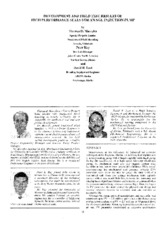| dc.description.abstract | Improvement in the efficiency of enhanced oil recovery techniques at the Kuparak, Alaska, oil field required replacement of reciprocating pump with a larger capacity centrifugal pump. During the specification of a high speed two-stage centrifugal pump, the mechanical seals and seal support system were identified as key factors for a successful installation. While not all encompassing, the mechanical seal pressure velocity (PV) parameter, does allow the user to gauge the duty level of a mechanical seal. Since low leakage mechanical seals typically operate with a very small fluid film between the stationary and rotating faces, significant friction and heat may be generated when the pressures and rubbing velocities become high. Thus, the higher the PV parameter, the more crucial the physical seal design and material selection become to minimize heat and maintain an acceptable life. Although the pump and seal manufacturer had successful seal experience up to PV = 2.1 million (psi-ft/min), the chosen pump configuration resulted in a PV = 2.7 million, or 30 percent above the previous experience. Venturing beyond the current state-of-the-art seal, PV parameter necessitates an extensive qualification program to ensure that pump reliability and process safety management practices were met. To accomplish these objectives, a stringent set of seal qualification requirements were prepared by the contractor and end user to satisfactorily demonstrate: No catastrophic failures during normal and transient operation, A predicted seal life in excess of one year, and a maximum leakage rate of 150 ml/hr. A total of 600 operating hr were accumulated, including 75 start/stops to prove the robustness of the mechanical seals. Analytical verification, test lab results, and field operating experience are presented. In addition, a method for grading the success of the test program results against the desired design criteria is included. | en |


